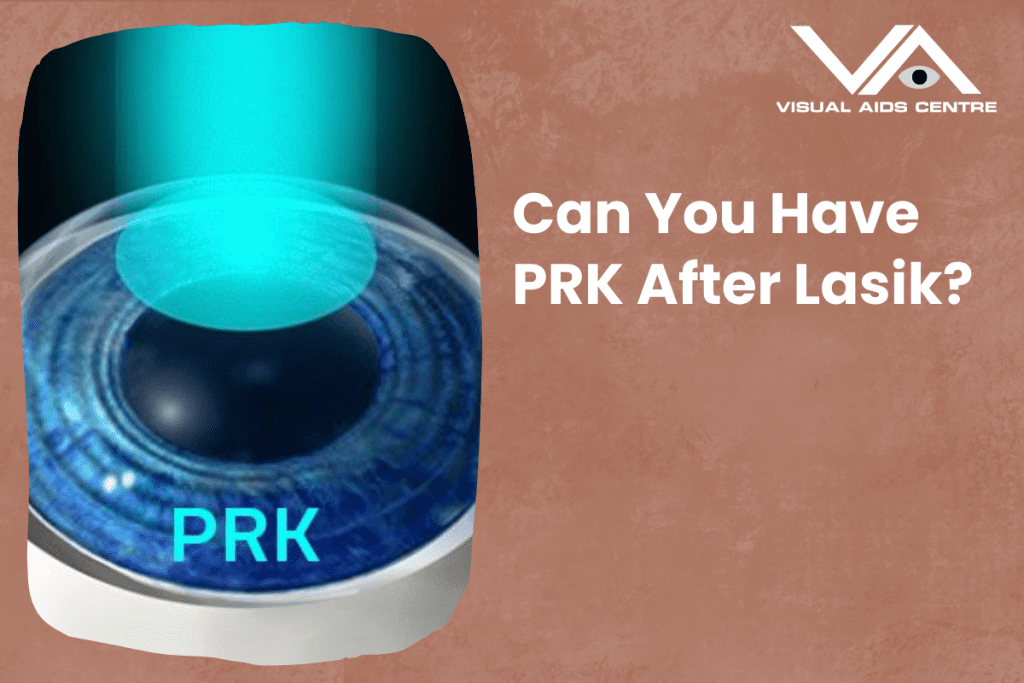Table of Contents
ToggleLASIK surgery gifted you glorious glasses-free vision, but time and ever-changing eyes can bring a desire for further refinement.
Fear not, fellow freedom seeker! PRK (Photorefractive Keratectomy) might be the answer.
This blog unveils the exciting possibility of PRK after LASIK, exploring the conditions that make it an option and the crucial factors to consider before taking the plunge for crystal-clear vision once again.

Understanding LASIK and PRK
LASIK and PRK are refractive surgeries aimed at correcting common vision problems such as myopia (nearsightedness), hyperopia (farsightedness), and astigmatism by reshaping the cornea—the clear, front part of the eye responsible for focusing light onto the retina.
– LASIK: This procedure involves creating a thin flap on the cornea, lifting it, and then using a laser to reshape the underlying tissue. The flap is then repositioned, enabling rapid healing and quick visual recovery.
– PRK: Unlike LASIK, PRK involves the removal of the corneal epithelium (outer layer) before reshaping the corneal tissue with a laser. The epithelium regenerates naturally over time without the need for a flap.
Can PRK Be Performed After LASIK?
The short answer is yes, PRK can be performed after LASIK. However, there are several important factors that need careful consideration:
- Corneal Thickness: LASIK involves the creation of a corneal flap and the removal of underlying tissue. This alteration affects corneal thickness. For PRK to be safely performed after LASIK, there must be sufficient residual corneal thickness remaining.
- Healing and Stability: After LASIK, it’s crucial to allow enough time for the eyes to stabilise and heal fully. The cornea undergoes changes following LASIK, and performing PRK too soon after LASIK can lead to unpredictable outcomes. Most surgeons recommend waiting at least several months to a year before considering PRK.
- Reason for Retreatment: The underlying reason for needing a retreatment procedure plays a role. If the initial LASIK resulted in a minor under-correction, PRK might be a viable option for refining the vision. However, for more complex issues such as corneal irregularities or significant regression, alternative solutions or further assessments may be necessary. Each case is unique and requires careful evaluation by an experienced ophthalmologist to determine the most appropriate course of action.
- Risks and Complications: Undergoing PRK after LASIK carries unique considerations and potential risks. The presence of a corneal flap from the previous LASIK surgery may impact the healing process and increase the risk of complications such as haze or irregular astigmatism.
- Your Overall Eye Health: Any pre-existing eye conditions like dry eye or infections need to be addressed before considering PRK.
Why Might You Need PRK After LASIK?
There are several reasons why someone might need PRK following LASIK surgery:
- Undercorrection or Overcorrection: Sometimes, the initial LASIK procedure doesn’t fully correct your refractive error (nearsightedness, farsightedness, or astigmatism). This can leave you with residual refractive error, requiring further correction through PRK. This is commonly referred to as a LASIK enhancement or touch-up procedure.
- Regression: Over time, your vision may slightly regress after LASIK. PRK can be used to refine the corneal shape and improve your vision again.
- Corneal Issues: In rare cases, LASIK can cause complications involving the corneal flap created during the procedure. PRK can be a safer option for retreatment in these situations, as it doesn’t involve manipulating the flap.
The Process of PRK After LASIK
If you are contemplating PRK after LASIK, here is a general overview of what you can expect:
– Comprehensive Evaluation: Your eye surgeon will conduct a thorough evaluation of your eyes, including measurements of corneal thickness, corneal curvature, and overall corneal health. This evaluation will help determine the suitability and safety of PRK after LASIK.
– Stabilization Period: You will need to wait until your corneas have fully stabilised post-LASIK. During this period, any residual effects of LASIK, such as fluctuations in refraction or corneal shape, should resolve.
– Procedure: The PRK procedure begins with the removal of the corneal epithelium using either a gentle brush or an excimer laser. The underlying corneal tissue is then reshaped with the same type of laser used in LASIK. Since there is no flap involved, the corneal tissue is directly reshaped.
– Recovery and Healing: Following PRK, the epithelium will naturally regenerate over several days to a week. During this time, you may experience discomfort, light sensitivity, and blurry vision. Over the ensuing weeks and months, your vision will gradually improve as the cornea heals and stabilises.
– Follow-Up Care: Regular follow-up appointments with your eye surgeon are essential to monitor healing progress, address any concerns, and optimise visual outcomes.
Weighing the Pros and Cons: PRK After LASIK
Considering PRK after LASIK involves weighing the pros and cons to make an informed decision:
Pros:
– Safe alternative for individuals with thin corneas who aren’t LASIK candidates.
– Effective in correcting residual refractive errors or regression after LASIK.
– Suitable for patients with pre-existing corneal irregularities.
Cons:
– Longer and potentially more uncomfortable recovery compared to LASIK.
– Increased risk of corneal haze, although manageable with medication.
– Possible dry eye symptoms post-procedure, which can be treated with artificial tears or medication.
Ultimately, the decision should be made in consultation with your ophthalmologist, considering your unique eye health and vision correction needs.
Summing Up
While PRK can indeed be performed after LASIK, it is imperative to consult with a skilled and experienced eye surgeon who specialises in refractive surgery.
Factors such as corneal thickness, healing patterns, and the presence of a previous corneal flap will be carefully evaluated to determine the feasibility and safety of PRK post-LASIK.
If you are considering further vision correction or enhancement after LASIK, seek personalised guidance from an eye care professional who can provide tailored recommendations based on your unique eye anatomy and vision goals.
By taking a proactive and informed approach, you can make confident decisions regarding your vision health and achieve the clear, crisp vision you desire.













